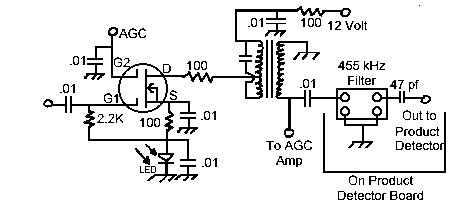




|
Three of these amplifiers are used in series to build the 455 kHz IF amplifier. AGC voltage comes from the AGC Circuit. The diagram above shows the circuit for the second IF amplifier. For better performance, a inexpensive 6 kHz bandwidth 455 kHz ceramic filter can be used between the Second IF Amplifier and the Diode Product Detector. This lowers the noise output of the IF amplifier strip and makes for a quiet receiver. A .01 coupling capacitor is used to couple to the filter, or if you don't have a filter in the circuit, to the Diode Product Detector. The drive to the audio amplifier can be adjusted by changing the output capacitor between 47pf to 300pf. Higher values give more drive. Find the right value to prevent distortion at full volume of the audio amplifier. The First IF Amplifier can have a inexpensive 455 kHz ceramic filter at the input to filter unwanted noise from the mixer, and also has the optoisolator for the S Meter Circuit. The Third IF Amplifier output connects directly to the diode of the AGC Circuit with no coupling capacitor. A .01 coupling capacitor is used between the output of Second IF amplifier and the Diode Product Detector.
The original inspiration for this IF strip came from the "Progressive Communications Receiver" in most of the recent ARRL Handbooks. That circuit is used at 9 MHz, uses two stages, and uses an LED (or two diodes in series) to raise the circuit ground of the MOSFETs. It is also a broadband circuit and could be used at any IF frequency given the limitation of the ferrite cores used. AGC performance falls with higher frequencies (10 MHz to 20 MHz), but works very well for 9MHz and below. The Cadillac of all MOSFET IF strips is "A Universal MOSFET IF Amplifier", by Georges Ricaud, and Doug DeMaw, QST, August 1981, Page 27. This circuit uses large red LED's which on the author's batch gave a 2.1 volt reference for the sources. He has two different AGC outputs, one that can be used at the RF amplifier or at the post mixer amplifier in this LED MOSFET receiver. The idea of using a 100 resistor in series at the drain was used in this receiver instead of swamping the output coil with a 2.2K resister like in the Progressive Communication Receiver. Ricaud's circuit uses a series 100 ohm resistor at G1 as well as at the drain. This is a great idea for using the MOSFET at higher frequencies, i. e., like the 9 MHz that Ricaud's circuit is designed. He uses a MC1350 AGC amplifier, which is needed for great AGC action at 9 MHz. You would want to use this circuit if you wanted to design a single conversion MOSFET receiver, instead of the dual conversion scheme of the LED MOSFET receiver. Another MOSFET IF strip worth looking at is "DX Receiver for the Ham Bands", by Ovi Florea, Ham Radio, December 1976, Page 10. His MOSFET amplifiers used a minimum of parts with 455 kHz Radio Shack cans, but does not reference the sources above ground, or use any 'oscillation tamers' (swamping resistors or ferrite beads) on the MOSFETs. I have found that when source resistors of 270 to 470 ohm are used, that the gain of the mosfets are considerably lower over the 100 ohm source resisters used in LED MOSFET receiver. This may be how he gets away without the "oscillation tamers". The need to have to supply a negative voltage for the AGC circuit makes this circuit obsolete.
|
Return to: Amateur Radio Receivers ||
LED Mosfet Receiver
|| Send E-Mail
